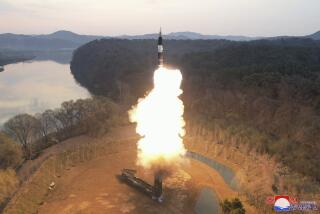N. Korean Alert to Ships May Signal Second Missile Test
- Share via
WASHINGTON — North Korea may be preparing to test its second missile in two weeks, Pentagon officials said Friday, citing a warning by the nation’s leadership for ships to stay out of one area of the Sea of Japan between today and Tuesday.
North Korea’s notice to mariners is almost identical to one announced before a test of a land-to-ship missile late last month, said Lt. Cmdr. Jeff Davis, a Defense Department spokesman. That test-firing was the first in three years.
Although tests of short-range missiles aren’t in violation of international agreements, they are “not helpful given the increased level of tensions that North Korea has caused,” Davis said.
The test-firing over the waters that separate the Korean peninsula from Japan came on the eve of the inauguration of South Korea’s president and was seen as a blunt new challenge by the North in its nuclear weapons standoff with the U.S. The missile fell into the Sea of Japan.
The launch was downplayed by the Bush administration and the new South Korean government of President Roh Moo Hyun. But it raised alarm in Asia, where stock markets fell and pacifist Japan recalled with a shudder the long-range North Korean Taepodong 1 missile that streaked over the Japanese mainland and landed in the Pacific in 1998.
Two days after the latest test, U.S. intelligence officials said North Korea had restarted a reactor at its primary nuclear complex that over time could provide a continuing source of plutonium for nuclear weapons.
Tensions escalated last weekend when North Korean fighter jets intercepted a U.S. surveillance plane over the Sea of Japan. This week, Defense Secretary Donald H. Rumsfeld ordered 24 B-52 and B-1B bombers transferred to a U.S. base on the Pacific island of Guam.
U.S. defense officials sought to minimize the significance of Friday’s warning to mariners of an “exclusion zone” off North Korea’s coast, saying that if it is a precursor to a test similar to the one last month, it would involve a small weapon and not one of North Korea’s stockpile of long-range ballistic missiles. After the 1998 test, the country agreed not to test long-range missiles.
“These moves are not aggressive in nature,” Davis said. “But we don’t see how it could be helpful, either, if they were to do the test.”
But a test of another Taepodong 1, or of one of North Korea’s new, longer-range Taepodong 2 missiles, which are believed to be capable of hitting targets in the western United States, would likely be considered highly destabilizing.
The South Korean government has become increasingly alarmed in recent days about developments in Pyongyang, the North’s capital, and in Washington. South Korean officials are particularly worried that the United States will conduct a military strike against North Korea, which could provoke Pyongyang to retaliate against Seoul. The South’s capital is within artillery range of the demilitarized zone between the two Koreas.
On Thursday, Rumsfeld said the United States was studying ways to move U.S. troops out of Seoul, fueling speculation that the Pentagon was contemplating a preemptive strike on North Korea.
In a sign of growing irritation with Washington, South Korean Defense Minister Cho Young Kil told the country’s National Assembly on Friday that Seoul had not been consulted about any troop movement and that such action should not take place until tensions with North Korea are resolved.
*
Times staff writer Barbara Demick in Seoul contributed to this report.
More to Read
Sign up for Essential California
The most important California stories and recommendations in your inbox every morning.
You may occasionally receive promotional content from the Los Angeles Times.













